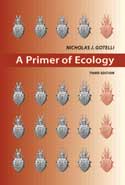| Aging | Crime | Ecology | Evolution | Political Science | Psychology | USA Modern History |
 Disclaimer
Disclaimer
 Links.
Links.
 Books read recently.
Books read recently.
 Best books read.
Best books read.
 Harry Potter books.
Harry Potter books.


| A Primer of Ecology by Nicholas J. Gotelli. |
